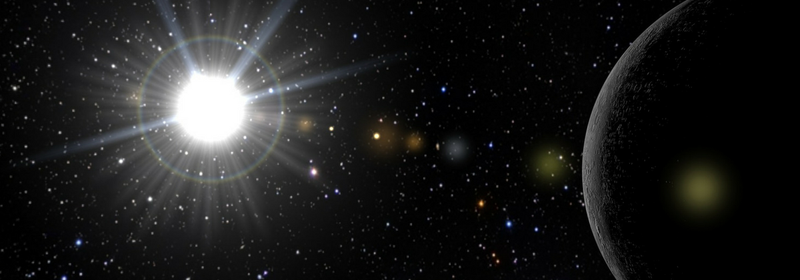
Fact, Fiction, or Future: The Warp Drive
“I canna change the laws of physics, Captain!” –Scotty, Chief Engineer in "Star Trek"
Article Header
« Return to Main PageFact, Fiction, or Future: The Warp Drive
“I canna change the laws of physics, Captain!” –Scotty, Chief Engineer in "Star Trek"
Introduction
The story of Star Trek has become a cultural phenomenon in recent decades. Almost everyone who owns or has owned a television has heard of the venerable Starship Enterprise and its five year mission to explore the universe. Throughout the show travel from planet to planet and star to star is presented as a routine and simple endeavor. However, any organization that has seriously investigated long distance space travel knows it is not that easy. Space is just that...space. Its distances boggle the human mind and make Captain Kirk wannabes cringe. Thankfully Star Trek had an answer for these concerns. The show introduced the concept of the warp drive, an engine that allows the Enterprise to travel vast distances through the universe in a period of a few episodes. This makes for good science fiction, but is it possible? Is the warp drive simply a writer’s fantasy or is it something more?
The Why
Why must something like a warp drive be invented to explore the universe? The true problem with traveling in space is the amount of time it takes to get from point A to point B. The star system nearest to the sun, at 4.4 light years away, is Alpha Centauri. “That’s about 25 trillion miles (40 trillion km) away from Earth – nearly 300,000 times the distance from the Earth to the sun” (Byrd, “How long to travel to Alpha Centauri?”). The fastest space vehicle created by man is the Voyager 1 probe launched by NASA in 1977. It is currently traveling at an estimated speed of more than 38,000 miles per hour. Though this appears to be quite fast and it is, “if Voyager 1 were headed toward Alpha Centauri, it would take between 75,000 and 80,000 years to get there” (Justo and Grazier 213). That timetable is far too long for any human or vulcan astronaut. So why not simply propel the spacecraft faster and faster until the timing is more reasonable? Well that idea sounds appealing and would be...if there was no catch, but just like any major highway, this universe has a speed limit.
The Speed Limit of the Universe
The fastest velocity any physical object can reach in this universe is about 300,000,000 meters per second. This, of course, is the speed of light. It is the fundamental basis for how much of the universe functions. Since its first calculation in 1676, the speed of light has been verified countless times by hundreds of scientists. This limit has yet to be broken and in all likelihood never will be. A spaceship, traveling under normal means, will never reach lightspeed. Even if an object could be made to go faster than the speed of light, the effort would be for naught. It would still take far too long to travel between stars. There is simply too much distance between destinations. So is all hope of interstellar space travel dashed? Not by a long shot, Scotty.
The Real Warp Drive
In 1994, a physicist by the name of Miguel Alcubierre hit upon a concept that could create a warp drive. He proposed that a spacecraft could create a kind of bubble in the “fabric” of spacetime that would allow for travel at superluminal or faster than light speeds. Travel in such a warp bubble would look eerily similar to a hyperspace jump in Star Wars. In one of the best examples of how fiction has influenced the study of science, Alcubierre explains how he came upon his idea. “People in Star Trek kept talking about warp drive[sic], the concept that you are warping space,” he says. “We already had a theory about how space can or cannot be distorted, and that is the general theory of relativity. I thought there should be a way of using these concepts to see how a warp drive would work”’(Kaku 204). The General Theory of Relativity, which will not be discussed in depth here, allows for loopholes in the speed limit of the universe. Just don’t use it as an excuse when given a speeding ticket.
Problems
While Alcubierre’s concept is clever and would allow for faster than light travel, it has some drawbacks that need to be addressed. First of all is the energy requirement. The sheer amount of power needed to create the “bubble” puts it out of reach of the world today, but not necessarily the world of tomorrow. It was only about a hundred years previous when a horse generated the highest level of energy. Imagine what the world will be able to create in the next hundred or even thousand years. A second concern is the requirement for an exotic matter to keep the “bubble” stable. Exotic matter is a fascinating, but odd concept in science. A prime example is negative matter. Negative matter can be illustrated this way. An avid bike rider is inflating one of the tires on his bike. If he puts negative matter into the bike tire, the tire will actually get flatter instead of filling up. That idea is weird, but is nonetheless necessary for almost any version of the warp drive to work. Modern scientists currently do not know how to create or store such matter, but, just like the energy problem, it may be easily available in the future. A final problem to consider is control. Once the “bubble” is created it is impossible to steer or alter destination. Captain Kirk and his crew had better hope Mr. Sulu typed in the right planet. Though this problem seems daunting, another physicist named Serguei Krasnikov came up with his own warp system that effectively eliminates this concern.
The Krasnikov Highway
Krasnikov changed the idea of warp “bubble” into a warp “tube.” The “tube” for example could connect earth to Alpha Centauri going one direction. A ship, such as the enterprise, would have to travel to Alpha Centauri under sublight speeds carrying the “tube” behind it. Once the sun and Alpha Centauri have been connected, the ship can simply return through the tunnel it has created, arriving back at our sun almost instantaneously. Because the “tube” is only one-way, two Krasnikov tubes would have to be created to allow two way travel, one to Alpha Centauri and one back.“Unlike the warp bubble where space is modified only temporarily, during the bubble’s passage, once the Krasnikov tube has been created, the space within remains modified” (Everett and Roman 122). This simply means the highway is permanent. Though creating such a tube would still require a tremendous amount of resources and especially time, it has greater plausibility than the unmodified Alcubierre Drive.
Conclusion
In the face of the sheer distance between objects in space, a spacecraft that can go faster than the speed of light is a necessity. When will such a device be built? It may be a hundred years, a thousand years, or maybe never, but a warp drive is based in reality. It would be difficult to create, but it is not impossible. For a while it seems, warp drives will be confined to the realm of science fiction.
Works Cited
Byrd, Deborah. “How long to travel to Alpha Centauri?” EarthSky, 16 May 2017, earthsky.org/space/alpha-centauri-travel-time. Accessed 28 Aug. 2017.
Kaku, Michio. Physics of the Impossible. New York, Doubleday, 2008. Print.
Everett, Allen, and Thomas Roman. Time Travel and Warp Drives. Chicago, The University of Chicago Press, 2012. Print.
Everett, Allen, and Thomas Roman. Time Travel and Warp Drives. Chicago, The University of Chicago Press, 2012.









